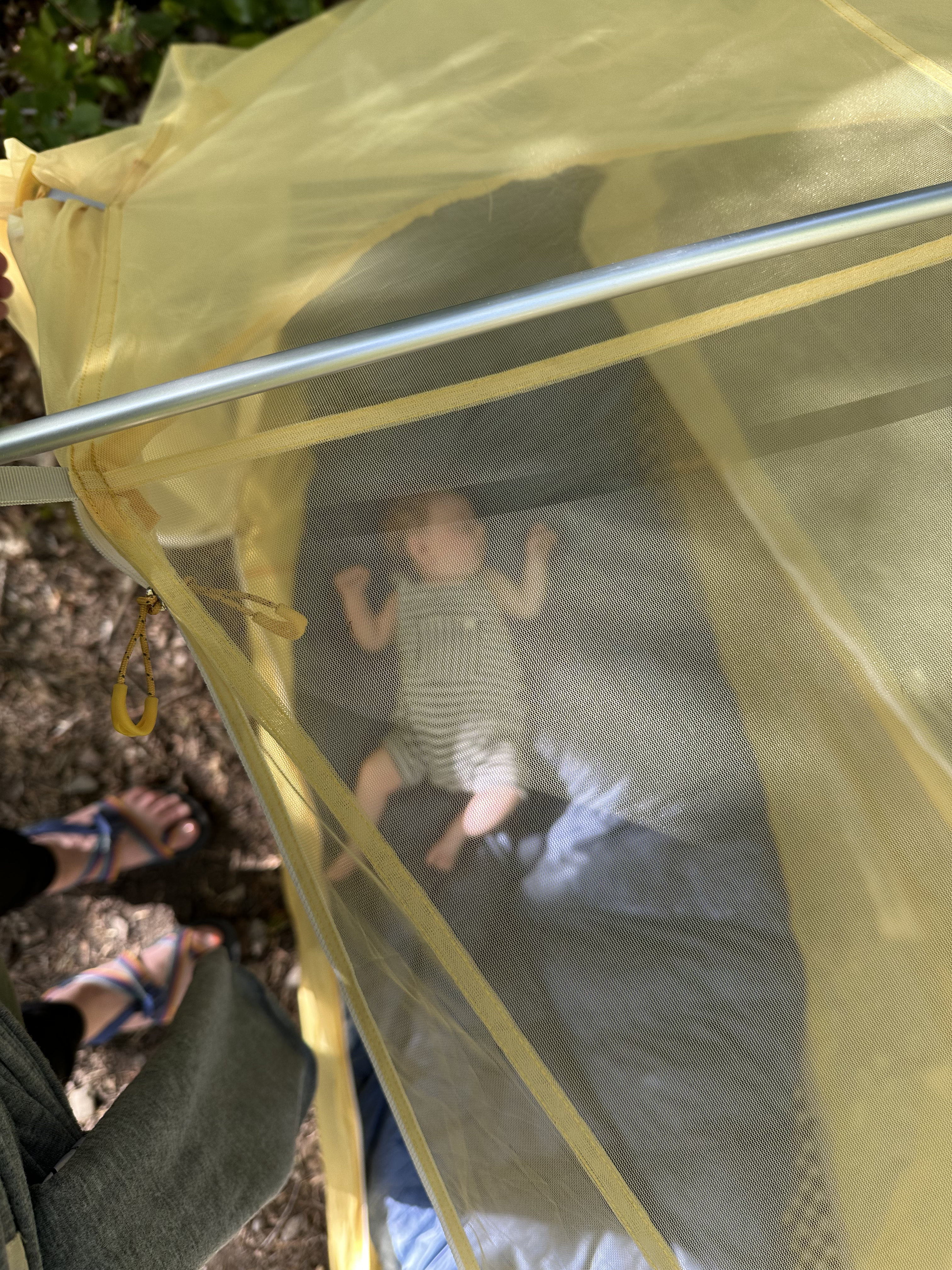2023 Granola Girl Gift Guide
Christmas Gift Guide for Granola Girls. Outdoorsy Girls Gift Guide. Outdoor gifts for your girlfriend.
Sleeping in a tent with a baby requires some extra planning and precautions to ensure your little one stays comfortable and safe.
Disclaimer: I’M NOT A SAFE SLEEP EXPERT, just a mom who has tried to camp safely with her baby. I recommend families do their own research, talk to medical providers or child safety experts about potential concerns, and lastly, listen to their parental instincts.
You will need to weigh out the risks of camping with your baby.
I’m also not going over specific safe sleep practices; I will leave that to parents to research outside of this article.
1. Test out your sleep setup at home.
2. Pick a firm sleep surface. This will look different car camping vs backpacking.
3. Considerations for camping in colder temperatures. R-Values matter.
4. Baby sleeping bag options - 0 month, 3 month & 6 month rated options listed.
5. Layering your baby in merino wool base layers at night.
6. Wake up through the night to check on your baby’s temperature when camping with young babies.
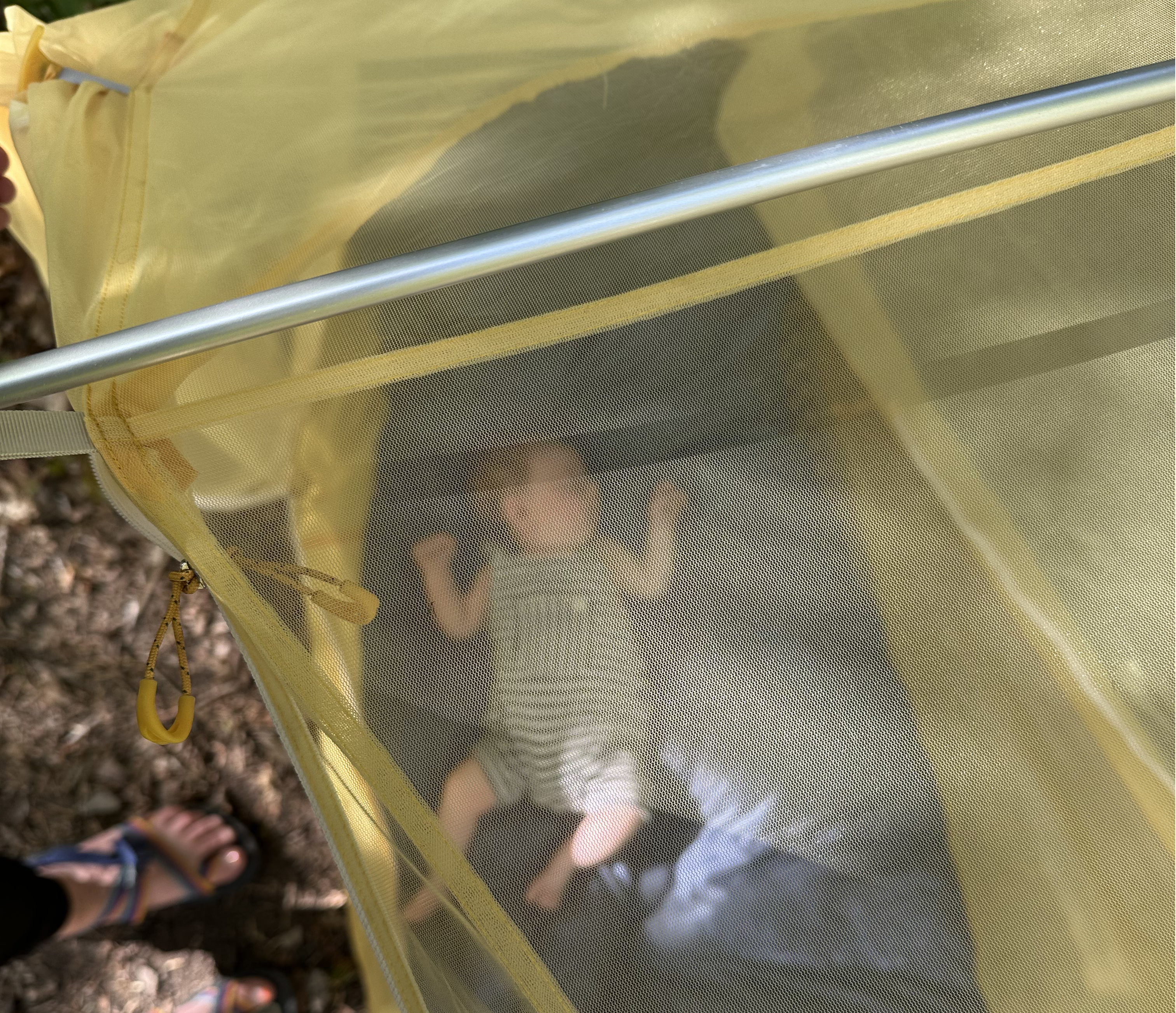
In simple terms, what you do at home to practice safe sleep with your baby is what you should do when camping.
But that’s easier said than done.
It is easier to achieve this when car camping. You can bring a large travel bassinet or crib and give your baby plenty of space in a large tent, or even utilize some type of travel trailer or van.
But it gets trickier when you are “roughing it” by sleeping on the ground or attempting backcountry camping.
Or start with a very small camping trip close to home, something you could easily bail on or have a back-up plan for if things aren’t going well.
My first camping trip with my first baby was a “shakedown trip.” My parents were staying in a nearby cabin that we could easily drive to. It gave me peace of mind as a very anxious first-time mom.
Babies should not sleep on inflatable pads for the first year.
For car camping, consider bringing a travel bassinet or crib. This ensures a firm and separate sleep surface for your baby.
There are lightweight, foldable travel bassinets like the Munchkin Brica Baby Travel Pod
or portable travel cribs like the Pamo Babe Travel Crib (we use this travel crib). Also really popular is the Slumber Pod.
Get creative with different types of firm but separate sleep spaces for your baby. Keep in mind that none of what I am going to mention is recommended by safe sleep experts or safety-rated. This is up to parent discretion. Some alternatives could be a laundry basket, moses basket (some are rated for safe sleep), a stroller bassinet attachment, plastic container (similar to hospital-style bassinets), or even a cardboard box.
DockATot actually makes a cardboard bassinet that is easily transportable and has been approved for safe sleep. I think they may be discontinuing this product and is currently half off!
Cardboard boxes or “specific baby boxes” are not CPSC-approved in the United States. But in other countries, it has been or still is common for hospitals to send parents home with a baby box for sleep if needed.
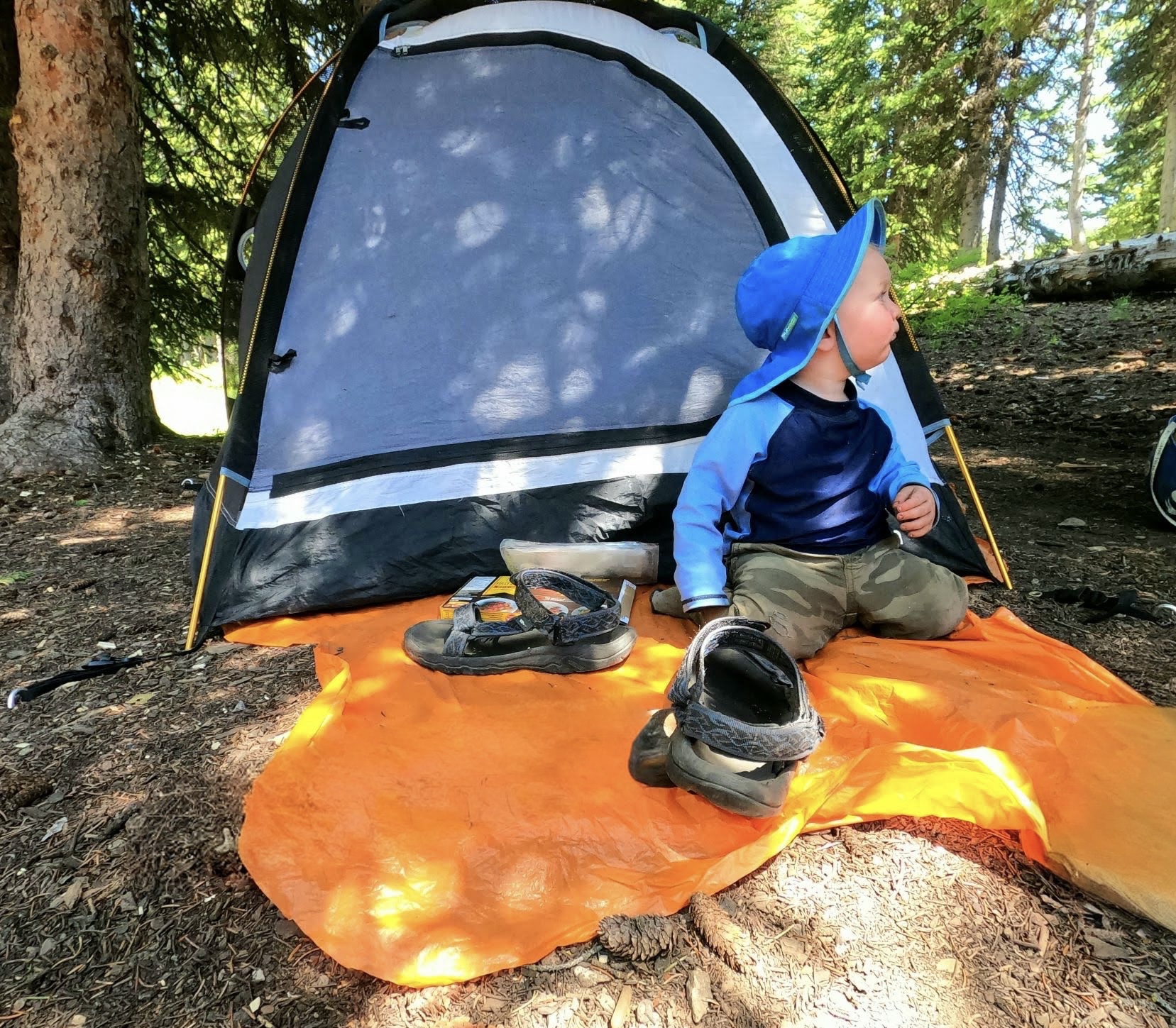
Getting more technical for colder temps. If you are planning to camp in mild summer temps this section may not apply to you.
When camping in tents, it is important to pay attention to how well insulated you are from the ground (i.e. what sleeping pad or mat you are using). We lose more body heat to the ground when camping than to the air temperature! This is why specific camp sleeping pads are given R-Value ratings. R-Value ratings help us determine how warm and how insulated a sleeping pad is. From there we can make sure our sleep products will sufficiently keep us warm.
Basic breakdown on R-Value Ratings:
How this relates to your baby?
If your baby’s sleep surface is flat and rests directly on the ground, you may need to add additional insulation under their sleep surface. Or consider making their sleep clothing warmer. But this all comes down to the temperatures you are camping in and essentially how cold the ground is going to get.
Most portable baby bassinet / crib pads aren’t going to give an R-Value rating. But typically it’s easy to assess that pads or mats in these products are thin (and not well insulating).
When camping with babies:
I first assess the overnight temperatures AND then what pad or mat my baby is sleeping on
If it’s a basic, thin pad with no R-Value rating AND I am camping in colder, 3-season temperatures
THEN I consider adding additional insulation under the initial sleep surface
Examples of additional insulation that could be placed under your babies sleep surace could include a closed-cell foam sleeping pad, a wool blanket, or even Reflectix.
If your baby’s sleep surface isn’t directly on the ground, do you still need additional insulation?
If your baby is elevated and not sleeping directly on the ground (likely a travel crib) they may not lose as much body heat, but if sleeping in colder temperatures you may still need or want additional insulation under their sleeping surface. It’s a similar principle to sleeping on a cot or even in a hammock when camping. Hammock sleepers who sleep without a pad or additional insulation in their hammock tend to get cold at night as the insulation in your sleeping bag compresses beneath your back and doesn’t do much for you in terms of warmth.
These recommendations obviously go beyond the scope of safe sleep in your home and parents have to decide what they are comfortable with.
When backpacking, you won’t have the luxury of using a travel crib or bassinet. However, some parents still prefer to bring a lightweight, foldable bassinet like the KidCo Peapod to maintain a separate sleeping space for their baby.
Other parents simply opt for a closed-cell foam sleeping pad or yoga mat to provide a firm sleep space for their baby when backpacking.
It is not recommended for babies under 1 year old to sleep on inflatable sleeping pads.
When backpacking, our preferred sleep setup was a closed-cell foam pad. We use the Therm-a-Rest Z Lite pad. It has an R-Value of 2 but can be folded in half to double the R-Value from 2 to 4 if needed (R-Values stack).
The Exped or Nemo closed-cell foam pads would work as well.
With my first baby I decided to keep my car camping sleep setup the same as my backpacking sleep setup to better acclimate my baby and keep things consistnet.
Your sleep sack at home likely isn’t going to cut it for camping with your baby. But luckily in recent years several baby specific sleeping bags have been designed for outdoor families.
The great thing about their baby sleeping bags is that they meet all AAP-recommended guidelines for safe infant sleep. They have no hoods or drawstrings, and the snug, soft collar is designed to prevent babies from potentially slipping inside.
Their bags range in price (dependent on fill material and size of bag) from $85 - $200.
Their bags come in two temperature ratings: 20F (down fill - more compressible, lightweight, and recommended for backpacking) and 40F (synthetic fill - recommended for car camping).
They offer three different size options:
Little Mo Baby Sleeping Bag (6-18 months) - recently changed from 6-24 months for a safer and snugger fit for small babies.
Big Mo Kids Sleeping Bag (18-36 months)
Mighty Mo Kids Sleeping Bag (3-5 years) Also new this year are adjustable hand cuffs on all their sleeping bags, a highly requested feature.
What about babies younger than 6 months? There are two options we have tried.
This sleeping bag has a lot to offer and is actually rated for babies as young as 3 months with its adjustable neck and arm openings (3 size adjustments).
Their bags also fit a wide range of sizes, allowing parents to use one bag for longer - from 3 months to 3 years old and from 2 to 6 years old. These bags are also very lightweight and compressible with their down fill, much like the Morrison Outdoors (down fill) sleeping bags mentioned above.
Another unique feature of this bag is its temperature adjustability. The bag alone is designed for temperatures of 40°F and above but was designed with the idea of combining with a down jacket for colder temperatures.
In addition, its two-way zipper can be left partially open for warmer temperatures, or the zipper can be separated, turning this sleeping bag into a traditional blanket or quilt!
Moreover, its clever elastic foot can either be sealed or folded up on itself and tied at the waist so your child can walk around camp with their bag still on!
For child safety, there are no sliding drawstrings or cord locks on this baby sleeping bag.
Their sleeping bags range in price (dependent on size), $230 - $280. Keep in mind their bags have the longest range of use 3 months - 3 years old or 2 years - 6 years old.
This is a highly underrated option that I hope to see more outdoor parents using!
This sleep sack was designed specifically for outdoor use, but it is only rated for temperatures between 50°F and 65°F. Parents would need to layer appropriately underneath for colder temperatures. However, it is one of the warmest options in the baby sleep sack category with a TOG rating of 3.5.
One of the benefits of this sleep sack is that they offer a size range from 0 to 6 months, as well as sizes for 6 to 18 months and 18 to 36 months.
These sacks have removable sleeves and were also designed with stroller buckles in mind, so your baby can stay warm and safely buckled in on walks.
Their sleep sacks range in price (dependent on size of bag) from $42 - $55.
Intended for 18 months - 3.5 years. These bags are length adjustable for a better fit based on your child’s age. These bags also have removable sleeves to work in varying temps. Their bags also come in a 20F and 40F.
Their sleeping bags range in price (dependent on fill material), $120 - $150.
You can find these sleeping bags online at Walmart.
Something like this Patagonia bunting. Patagonia’s down buntings are not only warm, but have a newborn size!
or even this Reima bunting (which actually snaps into a sleep sack). Reima products run big, usually a size - 2 sizes big. So keep that mind with your baby. It may not have a great tailored fit or too wide of a neck opening. This product may not show on Reima’s website unless winter.
Keep in mind that these products are not necessarily rated for safe sleep. Some parents will cut off the hoods of their baby buntings for “safer sleep”.
This is not recommended by the AAP and is up to parental discretion. If you choose to co-sleep, consider using a quilt instead of a sleeping bag. I love this REI quilt for backpacking.
I was co-sleeper with my first baby when backpacking. I still had him on a closed-cell foam pad, but I dressed him in a bunting / shared my backpacking quilt with him. Again, I am not recommending families do this. You should weigh out all the options and associated risks.
I switched my first kid to a kid sleeping bag around the age of 2 vs sleep sacks or baby / toddler speific sleeping bags. This is a very personal decision for parents.
Some of the benefits of a sleep sack-style sleeping bag or baby / toddler specific sleeping bags include: your toddler can’t slide or wiggle out of a sleep sack during the night, and a sleep sack provides a better fit. Typically, a sleep sack compacts down smaller and weighs less than a kid sleeping bag.
Beneifts of a kid sleeping bag include: often they cost less and the sleeping bag will last them longer than a sleep sack. The kid sleeping bag can be a little more versatile in terms of varying temps (unless comparing to the Milk and Honey sleeping bag).
I use the Big Agnes Little Red sleeping bag for my 4 year old.
Once you’ve chosen your sleep sack or sleeping bag, you’ll want to determine what layers your child will wear underneath.
Often, parents’ main concern is whether their baby will be warm enough, but they should also consider the possibility of overheating, which I think is more common. Babies aren’t able to regulate their temperature very well, especially if they overheat.
I highly recommend a merino wool base layer for camping babies. Wool has temperature-regulating properties - it helps you stay warm but also helps you stay cool. Wool will also keep you feeling warm even when wet, which can be helpful in case of nighttime diaper blowouts.
Wool is expensive, but I think an essential piece of gear if camping with babies (espeically young babies).
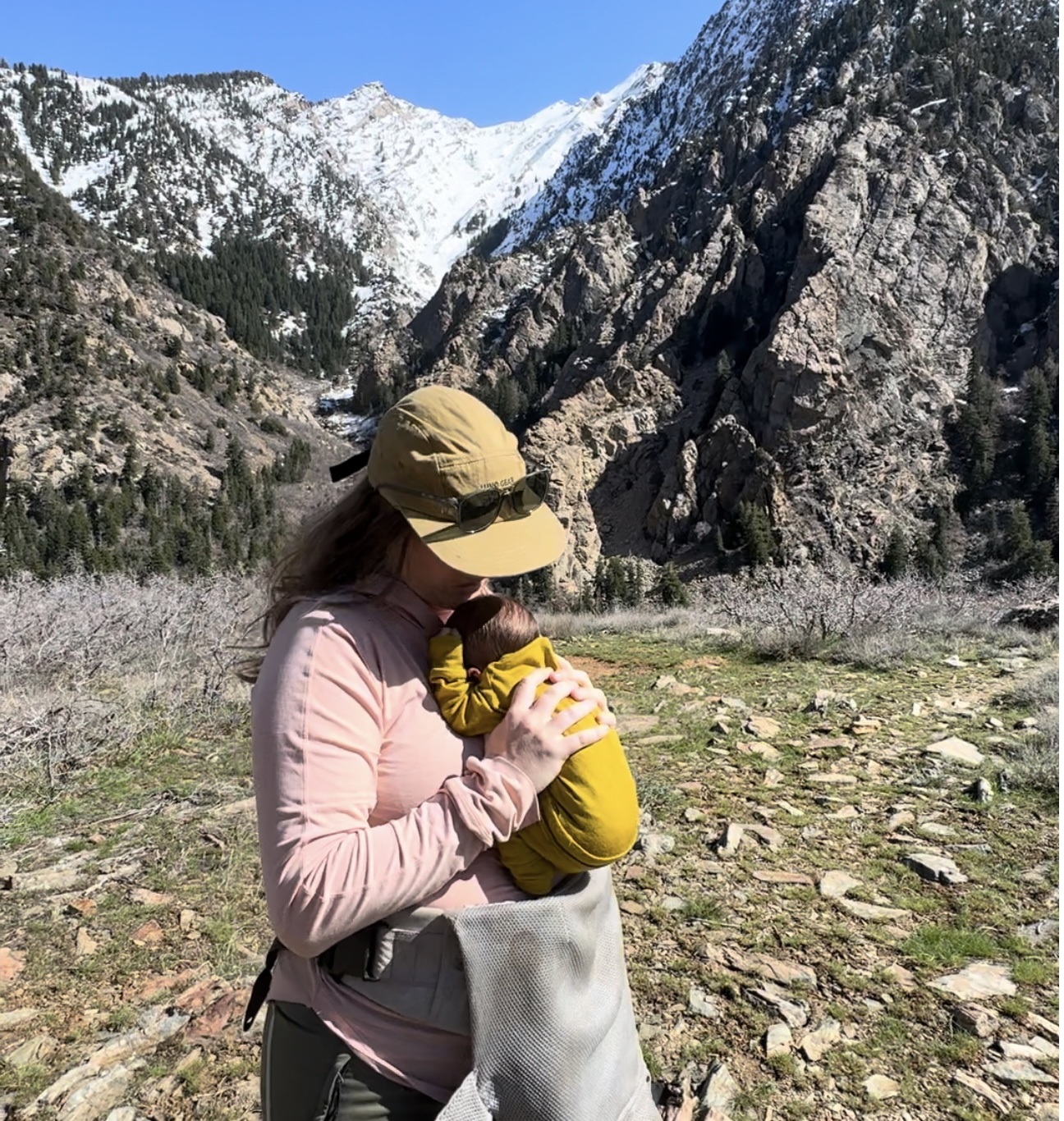
Suggestions for baby merino wool base layers:
Woolly Tots (shown above) - discount code Lauren10
Depending on the nighttime temperatures and the sleep sack you are using, you may also want to add a fleece mid-layer.
Additionally, I like to dress both my baby and toddler in some type of wool socks and a thin beanie. Iksplor makes a great thin wool baby hat.
If possible, I would gradually work up to colder temperatures. Give yourself time to troubleshoot your setup and determine what your baby is or isn’t comfortable in.
Let’s be honest, most moms camping or backpacking with young babies or kids often don’t get much sleep anyway, whether it’s due to additional comforting or simply checking to make sure they are okay through the night.
However, over time and with practice, you will be able to dial in the perfect sleep setup for your baby!
Babies may need more comfort when camping. If you are a breastfeeding mom, that might mean breastfeeding for comfort through the night.
Regardless of whether you are breastfeeding for comfort or for an actual feeding, you may want to consider what you are wearing for your comfort and to keep yourself warm. Iskplor also has merino wool nursing friendly tops for moms!
If your baby is formula-fed, I would recommend getting them used to taking bottles at room temperature or even straight from the fridge. Bottles won’t be warm when camping, especially backpacking. Personally, when I was bottle feeding, I liked to keep a bottle with the right amount of water in my sleeping bag with me to try and keep the water “warmer” for any nighttime feeds. Then, I would have formula accessible to mix when needed.
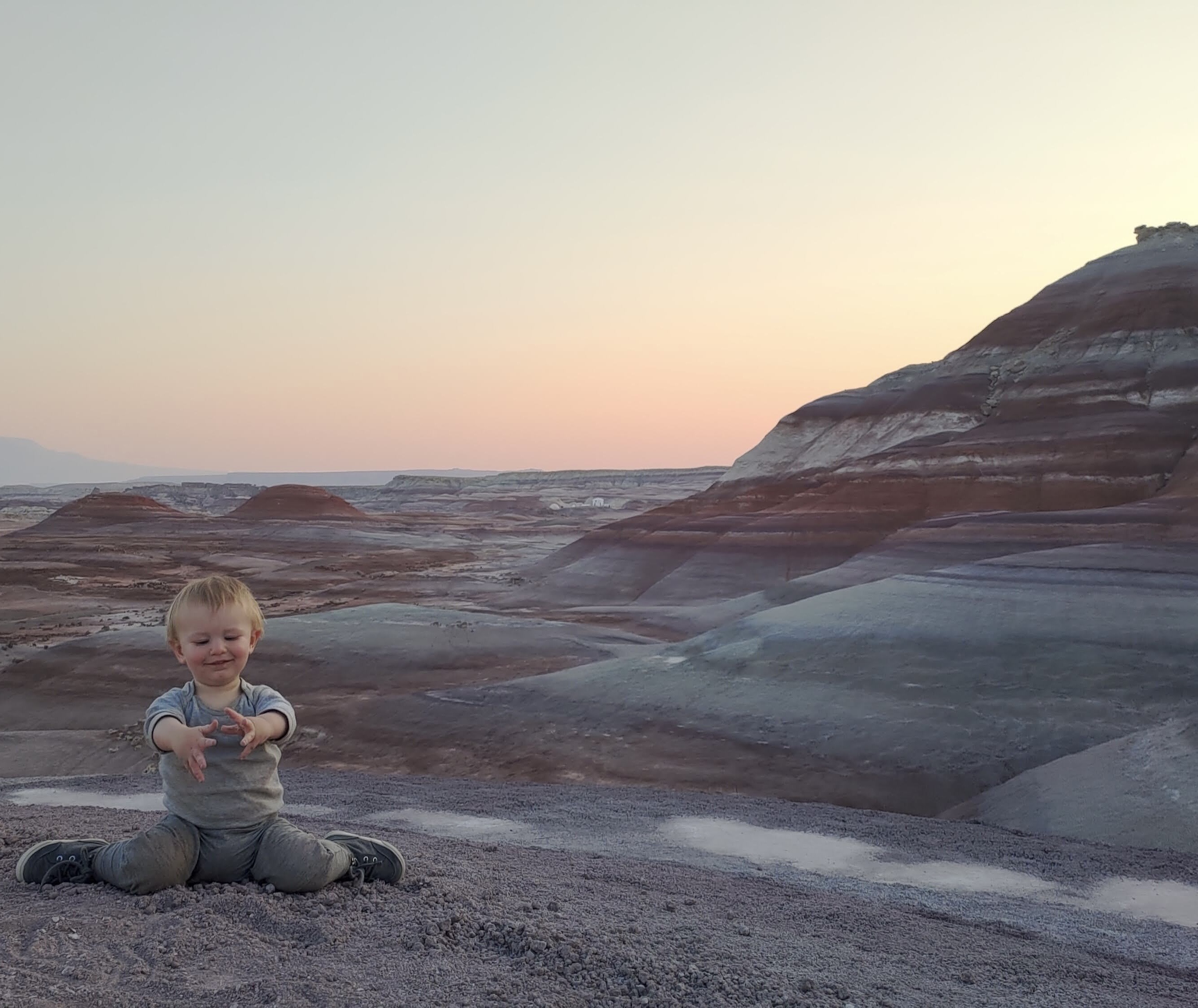
My last disclaimer. I want to acknowledge postpartum anxiety, postpartum depression, breastfeeding struggles, sick babies, birth injuries, etc. All of the above may be huge barriers for parents when it comes to camping or getting out with their babies.
In the adventure parenting space, there is often this unwritten standard of ‘getting out with your baby as soon as possible’. I felt it. I know others feel it too! I want to acknowledge that standard as unrealistic and unhelpful.
As a first-time mom with a birth injury, it greatly impacted my ability to get out on a walk, let alone go on an adventure with my baby.
So, my first piece of advice to parents wanting to adventure with babies: don’t compare yourself to other families, don’t give in to ‘pressures’, do what is best for your situation/family, and know that you are an adventure family regardless of when you started camping or adventuring with your baby.
